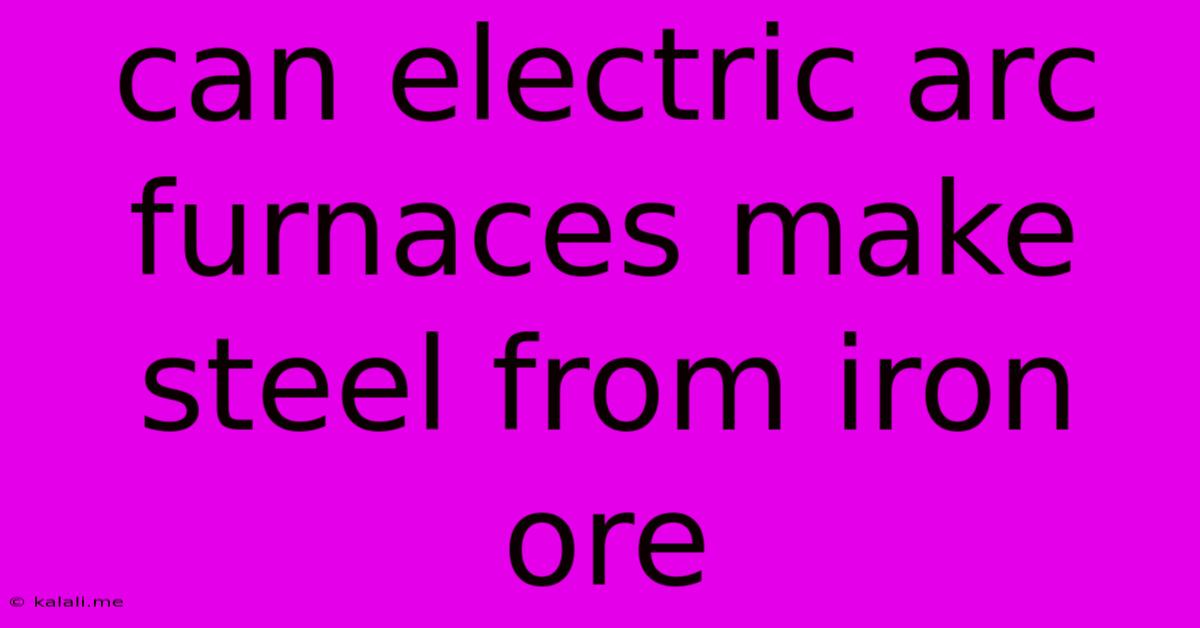Can Electric Arc Furnaces Make Steel From Iron Ore
Kalali
Jun 06, 2025 · 3 min read

Table of Contents
Can Electric Arc Furnaces Make Steel from Iron Ore? A Deep Dive into Steelmaking
Meta Description: Electric arc furnaces (EAFs) are a cornerstone of modern steelmaking, but can they produce steel directly from iron ore? This article explores the process, limitations, and future possibilities of using EAFs for direct reduction of iron ore to steel.
Electric arc furnaces (EAFs) are renowned for their efficiency in steel recycling and are a crucial part of the modern steel industry. But a common question arises: can EAFs produce steel directly from iron ore, bypassing the traditional blast furnace route? The short answer is: not directly, not yet. While EAFs excel at melting and refining scrap steel, the process of reducing iron ore to molten iron requires significantly different technology and conditions.
Understanding the Steelmaking Process
To understand the limitations, let's look at the traditional steelmaking process. Iron ore, primarily composed of iron oxides, needs to be reduced – meaning the oxygen is removed – to obtain metallic iron. This typically happens in a blast furnace using coke (carbon) as a reducing agent, at extremely high temperatures. The resulting molten iron is then further refined in a basic oxygen furnace (BOF) or an EAF to produce steel, removing impurities and adjusting the chemical composition.
Why EAFs Aren't Suitable for Direct Iron Ore Reduction
EAFs operate under fundamentally different principles. They use an electric arc to generate intense heat, melting down scrap steel and other metallic charges. They lack the reducing atmosphere and the necessary high temperatures and pressures required for efficient direct reduction of iron ore. The direct reduction process needs a controlled environment to manage the chemical reactions involved in the transformation of iron oxides into metallic iron. EAFs aren't designed for this controlled reduction process. Attempts to directly charge iron ore into an EAF would result in inefficient melting and poor steel quality due to the presence of impurities.
Alternative Routes to EAF Steelmaking from Iron Ore
While direct reduction in an EAF isn't feasible, there are alternative approaches that leverage the efficiency of EAFs while utilizing iron ore:
- Direct Reduced Iron (DRI): DRI is a process that uses other methods (like shaft furnaces or fluidized bed reactors) to reduce iron ore to metallic iron, usually using natural gas or hydrogen as a reducing agent. This DRI can then be efficiently melted and refined in an EAF, significantly reducing carbon emissions compared to the traditional blast furnace-BOF route. This is a prevalent method already being used in the industry.
- Hybrid Processes: Combining processes like DRI with EAFs offers a route to sustainable steel production that leverages both technologies’ strengths. This approach has seen significant investment and growth.
The Future of EAF Steelmaking and Iron Ore
The steel industry is undergoing a significant transformation, driven by sustainability concerns. Research is constantly exploring new technologies, aiming to create more efficient and environmentally friendly steelmaking processes. While direct reduction in an EAF remains a challenge, the integration of DRI with EAFs is rapidly gaining ground, offering a promising pathway for utilizing iron ore in a more sustainable way while maximizing the benefits of EAF technology. This allows for the use of renewable energy in the process, contributing to decarbonization efforts. Future innovations might even lead to the development of modified EAF designs or entirely new processes that bridge this gap.
Conclusion
In summary, while electric arc furnaces cannot directly produce steel from iron ore, they play a crucial role in the increasingly important DRI-EAF route, enabling a more sustainable and efficient steelmaking process. This approach offers a pathway toward reducing carbon emissions and promoting environmentally responsible steel production. The future of steelmaking is likely to involve further innovations and optimization of hybrid processes, integrating the strengths of different technologies to create a truly sustainable industry.
Latest Posts
Latest Posts
-
How To Open A Motion Detected Door Silently
Jun 07, 2025
-
Replace Shower Drain Cover No Screws
Jun 07, 2025
-
Replacing Graphics Card Makes Images Better
Jun 07, 2025
-
What Is The Planet That Is Closest To The Sun
Jun 07, 2025
-
Can You Get All Starters In White
Jun 07, 2025
Related Post
Thank you for visiting our website which covers about Can Electric Arc Furnaces Make Steel From Iron Ore . We hope the information provided has been useful to you. Feel free to contact us if you have any questions or need further assistance. See you next time and don't miss to bookmark.